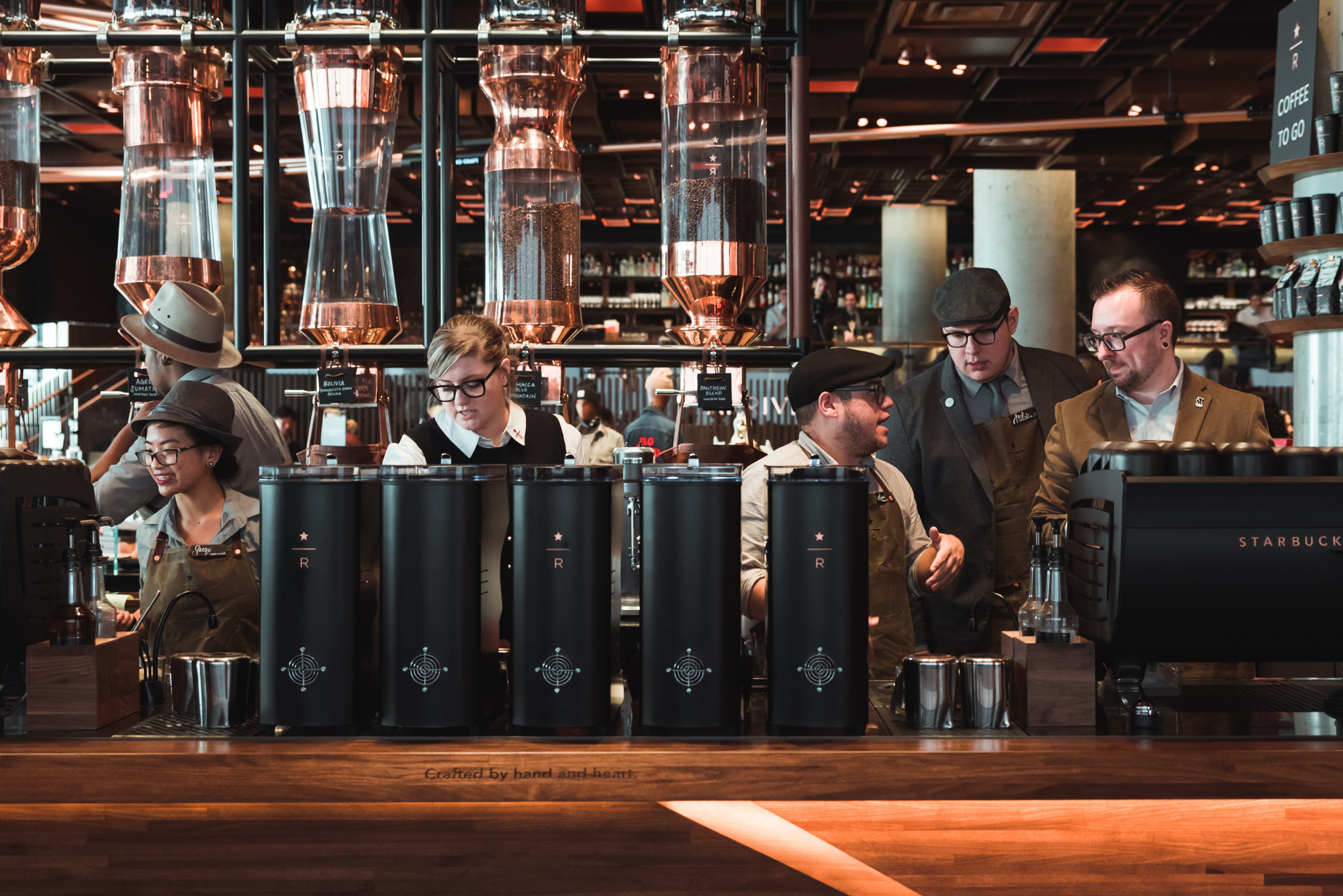- Starbucks opened a Reserve Roastery in New York on Friday.
- The new Starbucks Reserve Roastery is the fourth of its kind in the world and is completely unlike a typical Starbucks.
- The Roasteries are meant to be upscale, and they feature cocktail bars, bakeries, and unique elements.
The Roasteries – seen as competitors of more upscale coffee shops like Blue Bottle and Intelligentsia – typically include a high-end Princi bakery, full liquor bar, and lounge areas with fireplaces in addition to a more traditional coffee bar.
The New York store has all of these elements, plus an additional coffee bar, spread across three floors and 23,000 square feet of space. The Roastery showcases specialty, small-lot Starbucks Reserve coffee.
In comparison, a traditional Starbucks store averages around 1,800 square feet.
According to a company spokesperson, customers typically spend four times more in the company’s Roastery locations than in a traditional Starbucks. When visiting the Roastery, it was clear why – the store had tons of food and coffee options, plus plenty of places to sit and stay for a while.
The new location in New York is one of four Reserve Roasteries in the world, along with locations in Milan, Shanghai and Seattle. Starbucks plans to open additional Roasteries in Tokyo and Chicago in 2019.
We visited the new Roastery in New York and a typical Starbucks in the city's Financial District - here's how they compare:
We got an early peek at the Reserve Roastery on Wednesday morning. It's located in the Meatpacking District.

The store was overwhelming. To the left of the entrance was a big merchandise store.

There were products for sale from a few different collections, including Starbucks' New York collection and its holiday collection.

It was also selling coffee makers so customers can brew their own coffee at home.

Also on the first floor was the main coffee bar. Five hourglass-like units hold the freshly roasted coffee beans that are used in each order. The selection rotates seasonally.

Drinks were listed on printed-out menus, instead of on the overhead menus you typically find at Starbucks.

Baristas at the coffee bar, called "coffee masters," can use seven brewing methods, including pour-over, siphon, espresso, and cold brewing.

In addition to coffee, the main coffee bar sold fresh food from the attached Princi bakery ...

... and fresh fruit and jam.

The store had a very high-end feel to it.

Near the main coffee bar was a Princi bakery selling fresh breads ...

... baked goods ...

... and sandwiches.

The centerpiece of the first floor was a giant copper cask where beans are stored after they're roasted.

Coffee beans were being sent all around the store through a series of tubes that Chief Design Officer Liz Muller told reporters are "inspired by the history of the Meatpacking District."

Downstairs, we saw a second coffee bar named the "Experience Bar."

It was designed for customers to see all of the different brewing methods more in-depth that at the main coffee bar.

There were even more freshly baked desserts from Princi at the Experience Bar.

Also downstairs was the machine that roasts the coffee beans before they're sent to the cask, which can be seen from almost any point in the store.

Customers have the option to purchase freshly roasted beans to take home.

The top floor of the Roastery was the Arriviamo Bar, a complete cocktail bar that overlooks the Roastery.

The bar sold even more food ...

... coffee-based cocktails ...

... and an array of other drinks like wine and beer.

The store was filled with detailed design elements ...

... and there was even a "plants of Costa Rica" display, highlighting plants native to the area where Starbucks grows its coffee.

The store had plenty of seating throughout, including an area with a fireplace. It seemed catered more towards people who are looking to sit and stay for a while, rather than people looking to grab a coffee and go.

I stopped by a more typical Starbucks next, in the Financial District.

The store was a fraction of the size of the Roastery.

Unlike the Roastery, which had two coffee bars, a bakery, and a cocktail bar, this Starbucks only had one main bar with coffee and food.

There were a few counters to stand at and one communal table, and a few cushioned benches in the back.

There was a little bit of merchandise for sale, and most of it was holiday-themed. The products were mostly along the counter, rather than in a separate shop.

There were also a few different types of coffee for sale, but none of the freshly roasted blends that were available at the Roastery.

Almost all of the food was packaged, rather than fresh. A lot of the sandwiches were similar, but they looked much better at the Roastery.

The same went for all of the pastries available.

Visiting the Starbucks store in the Financial District was a completely different experience from visiting the Roastery.

The Roastery had much more to offer in terms of food, coffee, and cocktails. Overall, it was a much better experience, and it was completely unique from any other Starbucks store.

The only real downside was that the Roastery was more geared towards spending an extended amount of time in, as opposed to being a place to just grab a coffee and go.

